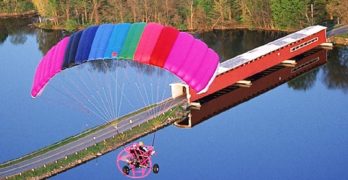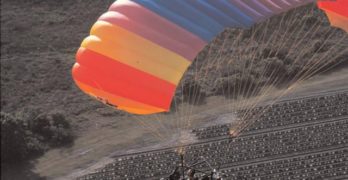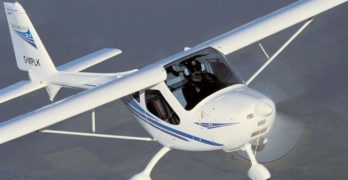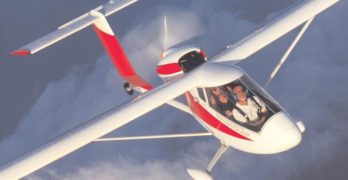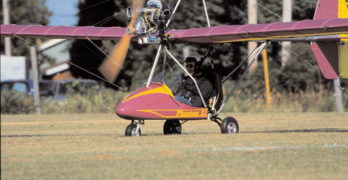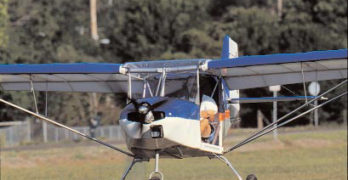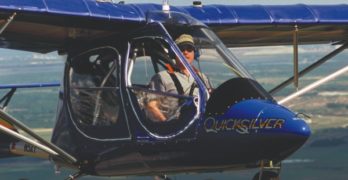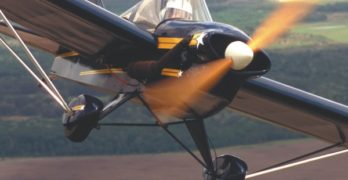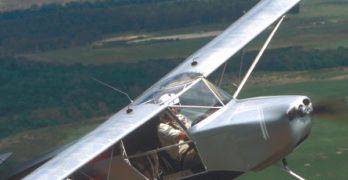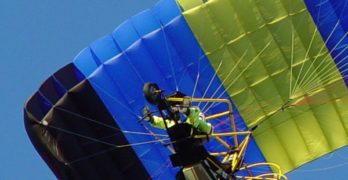For years, I’ve said that we misnamed the class of aircraft we call ultralights. We should call them ultraslows, because that’s what they do well-fly slowly.
Powered parachutes prove this point perfectly. One look at the 22 brands sold in the U.S. will tell you that they are robustly built-some weigh more than 400 pounds empty! Weight discussions virtually ignore the wing, but it’s the wing and its rigging to the carriage that dictate a parachute’s speed.
Powered parachutes are excellent at flying slowly. They take off, cruise, and land at about the same speed: 26 mph on average.
A Misunderstood Machine
When I first tried a powered parachute, I didn’t get it. Why would any one want to fly something so slow and unmaneuverable?
I prefer flying at slower speeds, so I wasn’t questioning the slow cruise speed. I objected to the one-speed-fits-all approach, equating this to a lack of ability to maneuver out of situations.
Search Results for : electric
Not finding exactly what you expected? Try our advanced search option.
Select a manufacturer to go straight to all our content about that manufacturer.
Select an aircraft model to go straight to all our content about that model.
Gemini Twin
A New Powered Parachute From a Well-Known Leader
Randy Snead branches out into his own company
Once an important figure in
Buckeye Industries, Randy is
known to many as the man
who worked on the technical
side and performed flight-testing for
Buckeye. When the former company fell
into struggle (see Editor’s Note), Randy
departed to do his own thing. Customers
who followed state, “It’s the people
behind the company” that are important.
I can find no argument with this
approach; we all tend to trust those we
know.
In turn, Randy is assisted by people he
trusts. His wife, Fern, is the business
manager and also operates the parts and
ordering department for the young firm.
Their son, Jeremiah, has experience in
general aviation aircraft, weight-shift
trikes, and powered parachutes, and he’s
built many powered parachutes. In the
EAA way, Gemini Powered Parachutes is
a family affair.
Introducing Gemini
Powered Parachutes
“It’s the American way” say others.
Germany’s Award-Winning Remos G-3 Mirage
“White, composite, and from overseas”…was a theme
of EAA AirVenture Oshkosh 2002 in the ultralight/lightplane
area. I’ve already congratulated Experimenter
Editor Mary Jones and Art Director Pierre Kotze on the
October issue’s beautiful layout of the aircraft from
afar, which may become near and dear to Yankee pilots.
This month,
I’d like to introduce
you
to one of the
new flock of white, composite,
and overseas aircraft—Remos Aircraft’s
G-3 Mirage.
For the second EAA AirVenture
Oshkosh in a row, I was delighted to
fly with Allistair Wilson, an Irishman
now residing in the United States.
Like last year, he is working with Rob
Rollison and the Rollison Light Sport
Aircraft Inc., based in Bloomfield, Indiana.
Last year, Allistair and I flew
in the Flight Designs CT. This year it
was the Remos G-3. Both are white,
composite, and from overseas. The
trend is real!
The Factory and People
In addition to flying with Allistair
at AirVenture, I also chanced to meet
the G-3 Mirage designer, Lorenz Kreitmayr,
at a French ultralight show
called Blois (the town it’s near).
The Vista A-20 Cruiser & Varlet
Eastern European designers deliver nimble machines
UPDATE–November 2008: According to FPNA, an American company with a business relationship to A-20 producer Aeroprakt, the A-20 has been discontinued. Please contact FPNA for more information (contact info at end of article).
As the new millennium got underway,
visitors to EAA
AirVenture Oshkosh 2000 examined
a new aircraft from a
Ukrainian company called Aeroprakt
Ltd. Named the A-22 Valor, the unique
side-by-side two-seat aircraft had a distinctive
cabin largely covered in clear
plastic. It was displayed by John Hunter
and his company, Spectrum Aircraft.
The Valor has turned out to be only
the first in a fleet of light aircraft that
have materialized before American eyes.
In 2001, another Aeroprakt model appeared
on Spectrum’s display space-the
A-20 Vista Cruiser, one of a series of A-20
models.
John Hunter became well
known in the light plane
world while working
for Phil Lockwood,
designer of the much-admired Air Cam.
Phamous Phantom
Phantom ultralights continue to charm many pilots
The proposed sport pilot and light-sport aircraft rule changes have been
the focus of much discussion and anticipation over the last several
months, and good reasons for such unbridled attention are plentiful.
Under the proposed rule, you can obtain
an FAA sport pilot certificate in as
little as 20 hours and then carry a passenger
without having to become a flight
instructor. Many interesting aircraft will
become available for purchase either as
kits or ready-to-fly light-sport aircraft
(LSA), and these machines will be more “capable” in that they will be faster, better
equipped, more comfortable, and
more closely resemble conventional aircraft.
In many ways, they will outperform
the general aviation aircraft they may
come to replace.
Experts expect financing and insurance
to become more readily available.
And access to America’s 12,000 airports
should follow. You’ll be able to buy fully
built LSA that will qualify for commercial
operations like flight training or rental.
Sky Ranger
The Leading Trainer in French Flight Schools
To many observers, the Sky Ranger looks like a RANS Coyote. Based on general appearances, it appears the French light plane borrowed heavily from the popular model sold by the Kansas light plane kit leader. But, Sky Ranger importer Richard Helm bristles a bit when he hears that statement and retorts, “People compare the Sky Ranger to the RANS Coyote. They say it’s a knockoff, but the French designer didn’t take anything from the Coyote. It’s built completely different,” although he admits, “It does look a lot like the Coyote.”
Give a Yankee welcome to the Sky
Ranger. The French-designed
ultralight is typical of a trend I
think we’ll be seeing with increasing
frequency—imported light planes from
Europe. Sky Ranger is built in the
Ukraine by Aeros, Ltd. I visited this
factory with Phil Lockwood of
Lockwood Aviation in the spring of
2001. Once built by Synairgy in France,
Sky Ranger production moved to this
former eastern-block country in 1997.
First to Achieve Light-Sport Aircraft Status?
Discounting coordination qualities, steep turns, well, all turns went very well in the GT 500; it is very precise in handling. You can always point the plane where you wish.
Many pilots, especially those trained in general aviation aircraft, love the yoke. I much prefer a joystick. This is personal preference, but you can’t fault the execution of the yoke arrangement in the GT 500. Like all components, it’s very well done.
Since I’d just flown the Flight Design CT before the
GT 500, comparisons were easy. Handling in the composite CT aircraft was much more fluid (though that may not suit everyone). The CT could also fly nearly as slowly over the fields as the GT 500, showing the possibilities in new aircraft designs.
The GT 500 behaved very properly at speed. Cruising at 90 mph indicated, the design felt very solid and gave every assurance. However, at 4,200 rpm and 50 to 55 mph, I experienced almost a continuous shudder that seemed to come from the tail.
Proven Design; Ison Aircraft’s Eros
The pretty blue Eros with bright yellow stars on it is no ordinary ultralight. On second thought, “ordinary” and “Eros” aren’t words that go together. Of those aircraft designed by Wayne Ison and his former TEAM team, this model is the hottest of the fleet. I believe I’ve flown all Ison designs that were put into manufacture and Eros is one of my favorites. (In truth, it’s a tossup between the Max-103, Air-Bike, and the Eros.)
The Legend of Davy Lee
For this month’s pilot report, I got the chance to fly a special Eros, a Grand Champion at Sun ‘n Fun ’98 in the Lightplane Class. It belongs to owner/builder/pilot Davy Lee Cooper and it represents my second review of an Eros.
Cooper’s Eros is Rotax 503-powered as was the earlier Eros I flew, but both are derived from the Eros-preceding V-MAX with a Half VW engine. Without a doubt the Rotax 503 is more energetic, yielding better climb rates and somewhat faster speeds.
An Escapade Just for You
Engineering design is usually an evolutionary process. While occasionally a breakthrough idea comes to market, most development in aviation is a result of small steps. The Escapade is a good example.
Once Flying K Enterprises (now Sky Raider LLC) offered their Sky Raider. The single-seater had much in common with the immensely popular SkyStar Aircraft Kitfox. In fact, when SkyStar offered their Kitfox Lite single-seater, Flying K built the welded fuselage for them.
Then came the Sky Raider II with a tight back seat that could be used for an occasional ride though not instruction as no controls were installed in the rear. The new Summit offered by Just Aircraft late last year was a variation on the Sky Raider II theme.
Company leadership changes as do their designs and the path from Flying K to Just Aircraft is convoluted; other business names are involved. By example, Rocky Mountain Wings, run by former Flying K partner Stace Schrader, offers their very similar Ridge Runner.
Gemini Powered Parachutes Come From Experience
According to the new Ultralight Flying! “Ultralight and Microlight Buyer’s Guide,” 24 companies are building powered parachutes in 2003. That figure doesn’t include recently announced foreign competitors and doesn’t count all that may follow. How does a new company stand out in such a crowd?
Gemini Industries boss Randy Snead is a well-known personality among powered parachute enthusiasts. He was the main technical person with Buckeye Industries, working with FAA personnel for months in pursuit of Primary Category certification. In blazing that new trail, Snead earned a reputation as being serious and knowledgeable.
His business enterprise is new to the scene, but given Snead’s long experience in this segment of light aviation, Gemini Industries should prosper. I see the company surviving any industry shakeout as the Indiana company keeps its overhead low and offers reliable products at low prices with reasonable delivery times. Gemini Industries isn’t flamboyant like some powered parachute producers and that’s exactly why Gemini’s formula should work.
- « Previous Page
- 1
- …
- 58
- 59
- 60
- 61
- 62
- …
- 67
- Next Page »


